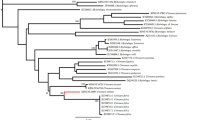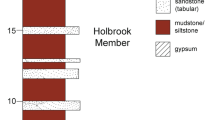Abstract
The fossil record of ponyfishes (Leiognathidae) is documented by the presence of skeletal remains and otoliths in Europe, Africa and Asia. Here we describe in detail a set of skeletal imprints from the Early Miocene (Burdigalian) of Harta locality (Poland). These specimens are morphologically identical and similar in meristic values to Leiognathoides minutus recently known from the Great Caucasian Basin. The studied remains exhibit a number of characters allowing to place this species within leiognathids. Among them, there are five osteological synapomorphies of the family Leiognathidae, as well as characters allowing to nest L. minutus within the Acanthuriformes. We suggest that the Western Tethys may have acted as a center of origin for ponyfishes, from which they migrated into different parts of the Paratethys. Using a seaway between the Tethys and Indian Ocean, leiognathids invaded the Indo-West Pacific and became diverse there, however went extinct in the Paratethys during the middle Miocene. Our data additionally corroborate the hypothesis about close connection between the fish faunas of the Carpathian and Greater Caucasian basins, and the possibility of a faunal exchange between different parts of the Paratethys during the Early Miocene.


Similar content being viewed by others
REFERENCES
Abraham, K.J., Joshi, K.K., and Murty, V.S.R., Taxonomy of the fishes of the family Leiognathidae (Pisces, Teleostei) from the West coast of India, Zootaxa, 2011, vol. 2886, pp. 1–18.
Agassiz, L., Recherches sur les poissons fossils, Vol. 4, Neuchâtel: Petitpierre, 1833–1844.
Bannikov, A.F., A new genus of ponyfish (Perciformes, Leiognathidae), J. Ichthyol., 2001, vol. 41, no. 1, pp. 112–114.
Bannikov, A.F., Fossil Vertebrates of Russia and Adjacent Countries. Fossil Acanthopterygian Fishes (Teleostei, Acanthopterygii), Moscow: GEOS, 2010.
Bannikov, A.F., The new genus Eoleiognathus for the percoid fish Pygaeus dorsalis Agassiz from the Eocene of Bolca in northern Italy, a putative ponyfish (Perciformes, Leoignathidae), Studi e Richerche sui Giacimenti terziari di Bolca, vol. 15, Verona, 2014, pp. 35–42.
Blow, W.H., Late middle Eocene to Recent planktonic foraminiferal biostratigraphy, Proc. of the First Int. Conf. on Planktonic Microfossils, Leiden: Brill, 1969, pp. 199–422.
Chakrabarty, P. and Sparks, J.S., Diagnoses for Leiognathus Lacépède 1802, Equula Cuvier 1815, Equulites Fowler 1904, Eubleekeria Fowler 1904, and a new Ponyfish genus (Teleostei: Leiognathidae), Am. Mus. Novit., 2008, vol. 3623, pp. 1–11.
Chakrabarty, P., Davis, M.P., Smith, W.L., et al., Evolution of the light organ system in ponyfishes (Teleostei: Leiognathidae), J. Morphol., 2011, vol. 272, pp. 704–721.
Daniltchenko, P.G., Bony Fishes of the Maikop Deposits of the Caucasus, Moscow: Academy of Sciences of the USSR, 1960. (Tr. Paleontol. Inst. AN SSSR, V. 78.)
Daniltshenko, P.G., Order Perciformes (excluding the Percidae), Fossil Bony Fishes of the USSR, Moscow: Academy of Sciences of the USSR, 1980, pp. 115–121, 125–169. (Tr. Paleontol. Inst. AN SSSR, V. 178.)
Garecka, M., Record of changes in the Oligocene–Miocene sediments of the Menilite-Krosno Series of the Skole Unit based on calcareous nannoplankton studies—biostratigraphy and palaeogeographical implications (Polish Outer Carpathians), Biul. Państw. Inst. Geol., 2012, vol. 453, pp. 1–22.
Garecka, M. and Olszewska, B., Biostratigraphy of the Early Miocene of the Southern Poland based on planktic foraminifera and calcareous nannoplankton, Przegl. Geol., 1998, vol. 46, no. 8/2, pp. 712–721.
Gill, A.C. and Leis, J.M., Phylogenetic position of the fish genera Lobotes, Datnioides and Hapalogenys, with a reappraisal of acanthuriform composition and relationships based on adult and larval morphology, Zootaxa, 2019, vol. 4680, no. 1, pp. 1–81.
Gill, A.C. and Michalski, S., Osteological evidence for monophyly of the Leiognathidae (Teleostei: Acanthomorpha: Acanthuriformes), Zootaxa, 2020, vol. 4732, no. 3, pp. 409–421.
Gill, T.N., Families and subfamilies of fishes, Mem. Nat. Acad. Sci. Wash., 1893, vol. 6, pp. 127–138.
Harzhauser, M., Kroh, A., Mandic, O., et al., Biogeographic responses to geodynamics: A key study all around the Oligo-Miocene Tethyan Seaway, Zool. Anz., 2007, vol. 246, pp. 241–256.
Hess, H. and Weiler, W., Untersuchungen an Fischen aus dem Alttertiär der Umgebung von Basel, Eclogae Geol. Helv., 1955, vol. 48, no. 9, pp. 427–447.
Ikejima, K., Ishiguro, N.B., Wada, M., et al., Molecular phylogeny and possible scenario of ponyfish (Perciformes: Leiognathidae) evolution, Mol. Phylogenet. Evol., 2004, vol. 31, no. 3, pp. 904–909.
James, P.S.B.R., Comparative osteology of the fishes of the family Leiognathidae, Part I: Osteology, Ind. J. Fish., 1985, vol. 32, pp. 309–358.
Jerzmańska, A., Rajchel, J., and Świdnicka, E., Nowe stanowisko ichtiofauny z warstw krośnieńskich jednostki skolskiej (Karpaty fliszowe), Geologia, 2001, vol. 27, no. 1, pp. 21–37.
Kimura, S., Kimura, R., and Ikejima, K., Revision of the genus Nuchequula with descriptions of three new species (Perciformes: Leiognathidae), Ichthyol. Res., 2008, vol. 55, pp. 22–42.
Kotlarczyk, J., Jerzmańska, A., Świdnicka, E., et al., A framework of ichthyofaunal ecostratigraphy of the Oligocene–early Miocene strata of the Polish Outer Carpathian basin, Ann. Soc. Geol. Pol., 2006, vol. 76, pp. 1–111.
Kovalchuk, O.M., Świdnicka, E., and Stefaniak, K., A new record of Gobius jarosi (Teleostei, Gobiidae) from the Early Miocene of Poland with inference to palaeogeography and palaeoecology of the Carpathian Basin, Hist. Biol., 2019, vol. 31, no. 10, pp. 1394–1401.
Kovalchuk, O., Baykina, E., Stefaniak, K., et al., A systematic revision of herrings (Teleostei, Clupeidae, Clupeinae) from the Oligocene and early Miocene of the Eastern Paratethys and the Carpathian Basin, J. Vert. Paleontol., 2020, vol. 40, no. 2. https://doi.org/10.1080/02724634.2020.1778710
Martini, E., Standard Tertiary and Quaternary calcareous nannoplankton zonation, Proc. of the II Planktonic Conference, Roma, 1970, vol. 2, Rome: Edizioni Tectoscienza, 1971, pp. 739–785.
Micklich, N., Bannikov, A.F., and Yabumoto, Y., First record of ponyfishes (Perciformes: Leiognathidae) from the Oligocene of the Grube Unterfeld (“Frauenweiler’’) clay pit, Päleontol. Z., 2017, vol. 91, pp. 375–398.
Nelson, J.S., Grande, T.C., and Wilson, M.V.H., Fishes of the World, 5th ed., Hoboken: Wiley, 2016.
Nolf, D., Otolithi piscium, Handbook of Palaeoichthyology, vol. 10, Stuttgart; N.Y.: Fischer, 1985.
Nolf, D. and Brzobohatý, R., Fish otoliths from the Late Oligocene (Eger and Kiscell Formations) in the Eger area (northeastern Hungary), Bull. Inst. R. Sci. Nat. Belg., Sci. Terre, 1994, vol. 64, pp. 225–252.
Olszewska, B., Otwornice warstw krośnieńskich w pobliżu V-tego horyzontu tufowego w Radziszowie (polskie Karpaty zewnętrzne), Kwart. Geol., 1982, vol. 26, pp. 627–645.
Pharisat, A., La paléoichthyofaune du Rupélien marin de Froidefontaine (Territoire de Belfort). Taxinomie et populations, genèse du gisement, implications paléobiogéographiques, Ann. Sci. Univ. Besancon, Geol., 4 sér. 1991, Fasc. 11, pp. 13–97.
Piller, W.E., Harzhauser, M., and Mandic, O., Miocene Central Paratethys stratigraphy—current status and future directions, Stratigraphy, 2007, vol. 4, no. 2/3, pp. 151–168.
Popov, S.V., Akhmetiev, M.A., Lopatin, A.V., et al., Paleogeography and Biogeography of Paratethys Basins. Late Eocene–Early Miocene, Moscow: Nauchn. Mir, 2009. (Tr. Paleontol. Inst. RAS, V. 292.)
Prokofiev, A.M., New and little known perciform fishes from the Upper Oligocene – Lower Miocene boundary deposits of the Caucasus (Osteichthyes, Perciformes), Zoosyst. Ross., 2002, vol. 11, no. 1, pp. 2009–2217.
Rajchel, J., Budowa geologiczna doliny Sanu w rejonie Dynów – Dubiecko, Biul. Państw. Inst. Geol., 1989, vol. 361, pp. 11–53.
Rajchel, J., Franus, W., and Franus, M., Mineralogical characteristics of the main tuffite horizon from Harta in the Skole Unit (Flysch Carpathians), Biul. Państw. Inst. Geol., 2001, vol. 396, pp. 128–129.
Reichenbacher, B., Gregorová, R., Holcová, K., et al., Discovery of the oldest Gobius (Teleostei, Gobiiformes) from a marine ecosystem of Early Miocene age, J. Syst. Palaeontol., 2018, vol. 16, no. 6, pp. 493–513.
Rögl, F., Palaeogeographic considerations for Mediterranean and Paratethys seaways (Oligocene to Miocene), Ann. Naturhist. Mus. Wien, Ser. A, 1998, vol. 99, pp. 279–310.
Rögl, F., Mediterranean and Paratethys. Facts and hypotheses of an Oligocene to Miocene paleogeography (short overview), Geol. Carpathica, 1999, vol. 50, no. 4, pp. 339–349.
Rückert-Ülkümen, N., Neue Funde von Capros breviventralis Rückert-Ülkümen (Pisces, Zeiformes) aus dem Tertiär von Thrakien, Türkei, N. Jb. Geol. Paläontol. Monatsh., 1994, no. 7, pp. 443–448.
Schwarzhans, W., Otoliths from the Miocene of West Africa, primarily from the Mandorové Formation of Gabon, PalaeoIchthyol., 2013, vol. 13, pp. 151–184.
Schwarzhans, W. and Bratishko, A., The otoliths from the middle Paleocene of Luzanivka (Cherkasy district, Ukraine), N. Jb. Geol. Paläontol. Abh., 2011, vol. 261, no. 1, pp. 83–110.
Siegel, J., Median fin-spine locking in the ponyfishes (Perciformes: Leiognathidae), Copeia, 1982, pp. 202–205.
Sikora, W., Wieser, T., Żgiet, J., et al., Tuff horizons in the Menilite-Krosno Series of the Flysch Carpathians, Bull. Acad. Pol. Sci., Ser. Sci., Chim., Geol. Geogr., 1959, vol. 7, pp. 497–503.
Sparks, J.S. and Chakrabarty, P., Description of a new genus of ponyfishes (Teleostei: Leiognathidae), with a review of the current generic-level composition of the family, Zootaxa, 2015, vol. 3947, no. 2, pp. 181–190.
Sparks, J.S. and Dunlap, P.V., A clade of non-sexually dimorphic ponyfishes (Teleostei: Perciformes: Leiognathidae): phylogeny, taxonomy, and description of a new species, Am. Mus. Novit., 2004, vol. 3459, pp. 1–21.
Sparks, J.S., Dunlap, P.V., and Smith, W.L., Evolution and diversification of a sexually dimorphic luminescent system in ponyfishes (Teleostei: Leiognathidae), including diagnoses for two new genera, Cladistics, 2005, vol. 21, pp. 305–327.
Steurbaut, E., Les otolithes de téléostéens du gisement de Peyrère à Peyrehorade (couches de passage de l’Oligocène au Miocène d’Aquitaine méridionale, France), Meded. Werkgr. Tert. Kwart. Geol., 1982, vol. 19, no. 2, pp. 35–57.
Van Couvering, J.A., Aubry, M.-P., Berggren, W.A., et al., The terminal Eocene event and the Polish connections, Palaeogeogr., Palaeoclimatol., Palaeoecol., 1981, vol. 36, pp. 321–362.
Weinfurter, E., Die Otolithen der Wetzelsdorfer Schichten und des Florianer Tegels (Miozän, Steiermark), Sitz. Österr. Akad. Wiss., Math.-Naturwiss. Cl., 1952, vol. 161/7, pp. 455–498.
Wieser, T., The Teschinite Formation and other evidences of magmatic activity in the Polish Flysch Carpathians and their geotectonic and stratigraphic significance, Fundamental Researches in the Western Part of the Polish Carpathians. Guide to Excursion 1. Carpatho-Balkan Geological Association 13 Congress, Cracow, 1985, pp. 23–36.
Yabumoto, Y. and Uyeno, T., A new Miocene ponyfish of the genus Leiognathus (Pisces, Leiognathidae) from Tottori Prefecture, Japan, Bull. Natl. Sci. Mus., Ser. C (Tokyo), 1994, vol. 20, no. 2, pp. 66–77.
Yabumoto, Y. and Uyeno, T., Euleiognathus, a new genus proposed for the Miocene ponyfish, Leiognathus tottori Yabumoto and Uyeno, 1994 (Perciformes: Leiognathidae) from Japan, Ichthyol. Res., 2011, vol. 58, pp. 19–23.
ACKNOWLEDGMENTS
The authors are thankful to P. Socha (University of Wrocław, Poland) for preparing the photographs of the studied specimens. A.F. Bannikov (Borissiak Palaeontological Institute, Russian Academy of Sciences) and N. Micklich (Hessisches Landesmuseum Darmstadt, Germany) are acknowledged for fruitful discussion. We are sincerely thankful to M.V. Nazarkin (Zoological Institute, Russian Academy of Sciences) and G. Carnevale (Università degli Studi di Torino, Italy) for important suggestions that qualitatively improved the manuscript.
Funding
The work was carried out with the grant support of the project 0121U110402 of the National Academy of Sciences of Ukraine for research groups.
Author information
Authors and Affiliations
Corresponding author
Rights and permissions
About this article
Cite this article
Kovalchuk, O.M., Świdnicka, E. & Stefaniak, K. Early Miocene Ponyfishes (Acanthuriformes, Leiognathidae) of the Carpathian Basin. Paleontol. J. 55, 421–428 (2021). https://doi.org/10.1134/S0031030121040092
Received:
Revised:
Accepted:
Published:
Issue Date:
DOI: https://doi.org/10.1134/S0031030121040092




